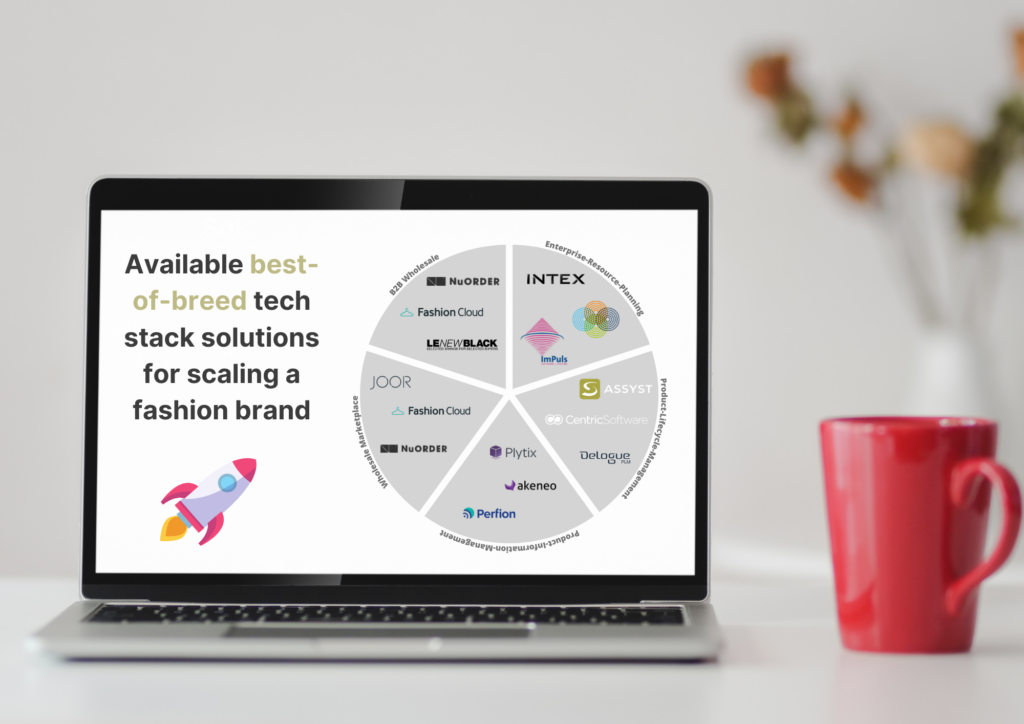
By Jessi Walker
6 minute read
Jessi Walker By Jessi Walker
6 minute read
There are several ways of approaching the digital needs of a successful and demanding company – with some being more future-proof than others for the survival of your fashion brand. Fashion CTOs need to follow a clear IT integration plan, as the strategic choices of past and present can quickly harm your business variability, market responsiveness and data security. Something you can cure yourself of with a carefully selected best-of-breed tech stack.
Companies who have relied on trusted legacy systems that successfully got them this far, now run the risk of losing their competitive edge from a lack of software updates and system integrability. Others implement all-in-one software from an external vendor for their enterprise-wide processes. These are capable of connecting operational data flows in a compact and convenient manner, but often lack the necessary depth in specific functionality. And there are those who commission an interconnected in-house system. Although a great alternative, it often requires more resources than the average fashion business can stretch for.
The IT and SaaS market has come a long way since legacy systems were in their prime. Now, customers can pick and choose from a collection of different programs and IT systems to suit their individual needs. That’s why so many Fashion CTOs are choosing to implement a tech stack of intuitive and integrable best-of-breed solutions – embracing digitalization by opting for a smooth and flexible data flow that provides expert functionality across all focus areas. In this article, we discover the distinct differences between the available IT system choices for modern fashion brands and the impact they promise to deliver on your overall business performance, data quality & security.
The Legacy System: A threat for future firm competitiveness
A legacy system is defined as outdated computer software that is still in use. While such a system usually still serves the purpose for which it was originally developed, it leaves little to no room for scalability, integration to other programs, or customization. Yet, these systems are so firmly rooted in the company structure that replacement efforts often get postponed for too long (spoiler: it doesn't get easier over time).
While fear of change, high initial investments and absent know-how are what stand in the way of transformative decisions, detaching too late from such systems can jeopardize the future of your fashion brand when lacking the power to keep up with current market requirements and the rapid pace of technological progress. Over time, your maintenance costs will only get higher and your data silos more complex. With higher exposure to potential data leaks and hacker attacks, this will also impose a threat for your compliance and overall data security.
The In-House System: A resource demanding trade-off
In-house systems are self-developed by a company to fully capture the corporations’ specific and individual needs and requirements. Internal software development consumes a lot of human and monetary resources, which means that in-house systems are more worthwhile for larger companies with special characteristics and unique process complexities. For SMEs on the other hand, a cost-benefit case is rather unlikely. This makes the decision for or against in-house system development more a question of preferences and capacities, and less a question of general expediency.
It isn’t just the high resource requirements that discourage many from in-house development. Many organizations are simply not equipped to develop software that ensures the same quality they would expect from a mature, external software provider. Through poor software design and a lack of control or defined standards, in-house software quickly becomes vulnerable to data breaches. In contrast, the software offerings of external vendors have gone through intense alpha and beta testing phases before their initial release, receive ongoing updates and can rely on the intel of ongoing use cases and reporting from their clientele.
While both terminologies (legacy system and in-house system) were covered separately here, they are by no means mutually exclusive. If you have self-developed your own in-house system a while back that fails to capture present technology’s full potential, then it can basically be classified as a legacy in-house system.
Best-Of-Breed Solutions: Boosting performance & responsiveness
In its essence, best-of-breed software is defined as the best available system for your individual needs in a specific niche or category. They seek to provide you with the best functionality, performance and user experience in a specific focus area of the value chain. When exploring a collection of solutions, it is important that 1) your chosen software vendors are easy to integrate to one another with intuitive data interfaces and 2) that you avoid too much fragmentation in your software selection.
In most cases, equipping yourself with integrable best-of-breed ERP, PLM and e-commerce systems will capture the digital needs of your value chain. Having a state-of-the-art software network that best meets the demands of the individual teams will boost efficiency and eliminate frustrating and costly pain points of an otherwise ill-fitting system.

Accelerate your time to market with transparent process flows by implementing best-of-breed ERP & PLM systems
ERP specializes in the efficient management of your product resources and finances, your hard product data (such as SKUs). Once all your budgets, forecasts and margin calculations are in place, you start executing on your designs. This is where a sophisticated PLM platform becomes essential - it focuses on the softer product data within development and supplier collaboration. A PLM allows you to have a transparent overview of your operative processes, allocate individual areas of responsibility along the development stages, and successfully negotiate and collaborate with suppliers in a single source of truth. Having a sufficient data integration between your hard and soft product data across these best-of-breed systems will improve data automation with speedier & more transparent process flows. This allows brands to significantly accelerate time-to-market and to intuitively access and distribute all product information for promotion and e-commerce purposes.
This is why all best-of-breed solutions have to be sufficiently harmonized, allowing them to talk to each other and extract information from one system to another. Otherwise, challenges with integration can also end up in costly delays. If you cannot manage to reach a smooth data- and workflow integration within your tech stack, valuable data assets can get lost or remain unattainable. Ultimately, the integration of best-of-breed software solutions needs to follow a thorough strategic roadmap where everything is planned out with comprehensive details and their respective impact on a company-wide level.
An integrated, future-proof best-of-breed tech stack as an access key for digital innovation
Working with reliable and integrable best-of-breed solutions throughout your full digital value chain will not only help you succeed throughout fashion’s current opportunities and challenges but also make you future-proof. With an integrable, responsive tech stack in place, fashion brands can easily scale and exploit the potential of new digital innovations, such as 3D technology. Ultimately, a strong data management structure is the key to survival in a fashion world that is turning more and more digital and is setting the scene for everything to come.
Delogue's Head of Product will be walking us through the map tech stack for supporting your ESG agenda. Along with CSR, Sustainability & ESG experts from the fashion industry, covering topics from the proposed EU Product Passport, Blockchain for transparency, Innovative materials and more.
